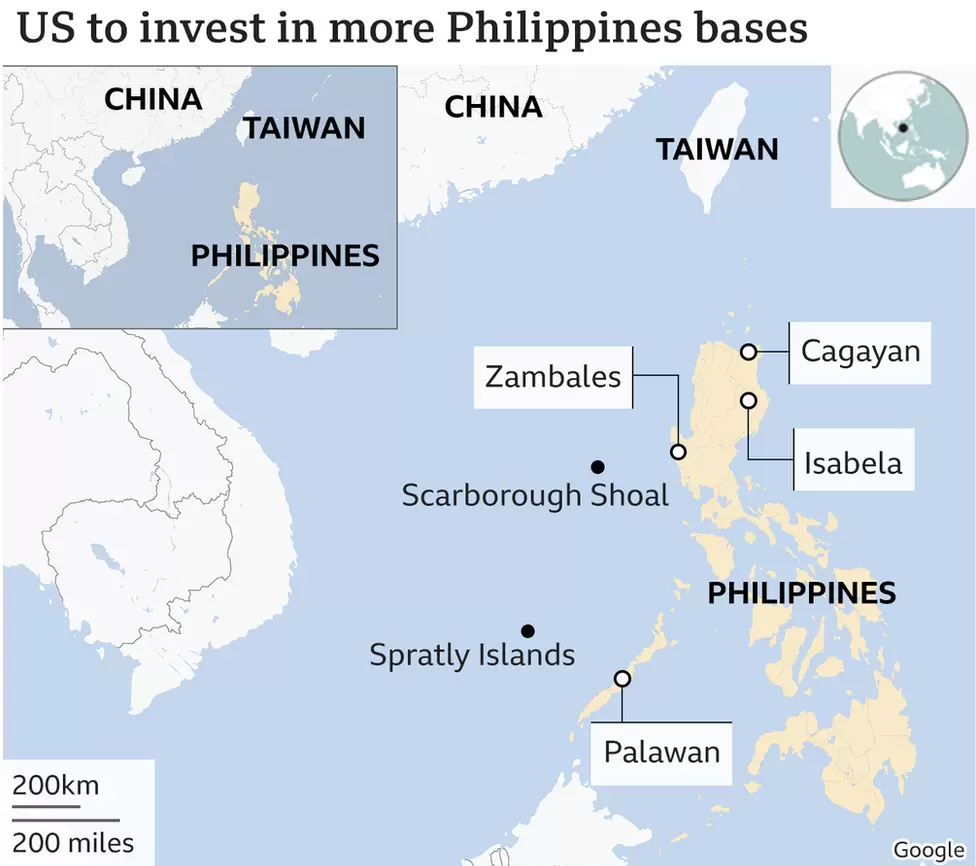Table of Contents
KEY POINTS :
- U.S. closes gap in the arc of its alliance in the region with the addition of Philippine bases.
- Philippines serves as a key front-line location for patrolling China near Taiwan and the South China Sea.
- U.S. expands access to the Philippines under the Enhanced Defense Cooperation Agreement for faster response to humanitarian and potential disasters.
- U.S. seeks access to locations for “lightweight and flexible” operations rather than permanent bases
- The return of U.S. to the Philippines is opposed by left-wing groups due to history of violence and abuse by U.S. forces.
The U.S has secured access to four more military bases in the Philippines under the Enhanced Defense Cooperation Agreement (EDCA), which allows for faster response to humanitarian and potential disasters. This expanded access is seen as a way to counter China’s presence in the region. The US seeks access to locations for “lightweight and flexible” operations rather than permanent bases.
Closing the Gap in the U.S Alliance
The US has secured access to four more military bases in the Philippines. This is a key piece of land that provides a front-line seat for patrolling China in the South China Sea and around Taiwan.
With this deal, Washington closed a gap in the arc of the US alliance that stretched from South Korea and Japan in the north to Australia in the south.
The missing link was the Philippines, bordering Taiwan and the South China Sea, or Manila’s claimed West Philippine Sea, two of the biggest potential flashpoints.
Expanded Access Under EDCA
The US had already restricted access to her five sites under the Enhanced Defense Cooperation Agreement (EDCA). This addition and expanded access “enables faster response to humanitarian and climate-related disasters in the Philippines, as well as other communal disasters.” Washington’s statement in response to the challenge” is likely a veiled reference to countering China in the region.
The statement was made after Secretary of Defense Lloyd Austin met with Philippine President Ferdinand “BonBon” Marcos Jr. in Manila on Thursday. The U.S. has not disclosed the location of the new bases, but there may be three in Luzon, the northernmost island of the Philippines, the only large piece of land outside of China near Taiwan.
An agreement that partially reverses America’s withdrawal from the former colonies more than 30 years ago is no small matter.
“There is no South China Sea emergency that does not require access to the Philippines,” says Gregory B. Poling, director of the Southeast Asia Program at the Center for Strategic and International Studies in Washington.
LGBTQ rights, Megachurch forces all members to take an oath opposing LGBTQ rights.
Access to Lightweight and Flexible Operations
“The United States does not want permanent bases. It is about location, not bases.”
They prefer access to a place with “lightweight and flexible” operations rather than a base with a significant number of troops stationed there, to put it another way. This isn’t a return to the 1980s, when the Philippines was home to 15,000 U.S soldiers and two of the biggest U.S military sites in Asia, close to Clark Field and Subic Bay.

The Philippine government finally declared the end of the conflict in 1991. The recent overthrow of Ferdinand Marcos’ dictatorship by the Filipino people will further solidify democracy and independence, as will the re-establishment of the former colonial rulers.
China continued to be a weak military power even after the Cold War and the Vietnam War had long since ended. Thus, the Americans returned home in 1992. Most individuals, at least, returned home. Another Marcos visits Malacanang Palace over 30 years later.
More significantly, China is no longer the weak military power pounding on the Philippines’ door. Beijing started to remap the South China Sea, and Manila was powerless to stop it. China has constructed 10 artificial island bases since 2014, one of which is on Mischief Reef, deep inside the Exclusive Economic Zone (EEZ) of the Philippines.
Until then, Manila-Beijing relations had not had major problems, says Herman Kraft, a professor of political science at the University of the Philippines. “We were in a life-and-death situation in the South China Sea. But in 2012 they tried to take control of Scarborough Shoal. Then in 2014 they started building the island. ”
“We have very limited options against threats from China,” said former Philippine Ambassador to the United States Jose Quicia Jr.
He says China has repeatedly broken promises not to militarize new bases in the South China Sea.
“China is militarizing these functions, which further threatens our territory. Only America has the power to stop them. The Philippines alone cannot.”
But this time, we won’t see the thousands of Marines and Airmen filling the red light districts of Olongapo and Angeles City again.
Opposition to the U.S Return

The history of violence and abuse by US forces in the Philippines remains a sensitive issue. An estimated 15,000 children were with their Filipino mothers when their American fathers returned home.
“Our relationship has a long history of inequality,” says Renato Reyes, general secretary of the left-wing group New Patriotic League. “The Philippines is forced to bear the social costs. It has a history of rape, child abuse and toxic waste.”
The return of the United States to the Philippines is staunchly opposed by left-wing groups in the country.
New Locations Facing the South China Sea and Taiwan
Although the U.S doesn’t have as many troops as it used to, Washington now seeks access to some new locations, some facing the South China Sea and others facing north toward Taiwan. There is Unofficial reports point to options in Cagayan, Zambales, Palawan and Isabela.
The first faces Taiwan, the second faces Scarborough Shoal, and the third faces the Spratly Islands. All new US facilities will be located within existing Philippine bases. US troops come in small groups and rotate.
The goal, Poling said, is to provide the United States with a place to monitor Chinese military movements around Taiwan while deterring China’s territorial expansion in the South China Sea. “The Philippines has no way to prevent China from leaving the alliance,” he said. “We are buying BrahMos missiles from India. The US wants to deploy Tomahawk cruise missiles. Together we can hold Chinese ships.”
The Philippines could even provide a “reverse access area” for US military operations and a place to evacuate refugees amid growing concerns over the dispute over Taiwan.
“People forget that there are 150,000 he to 200,000 Filipinos living in Taiwan,” Pauling said. But Manila has no intention of becoming a full member of the American alliance to challenge or resist China’s rise, Kraft warns.
“The Philippines, like Australia and Japan, does not directly challenge China’s interests in the South and East China Seas. President Marcos wants good relations with the United States. We want good relations with China to achieve economic benefits.”
Beijing has also shown that the new basic agreement between Manila and Washington will not allow it to disrupt relations with its neighbors.
In an editorial published to coincide with the US Defense Secretary’s arrival in Manila, China’s state-run Global Times newspaper said the US was “laying a trap for the Philippines” and “seeking to put it at the forefront of its confrontation with China.” condemned. ” . . Reyes believes China is as much a force for capitalism and imperialism as the United States.
“The Philippines still has a colonial spirit and they see the United States as their big brother.”

